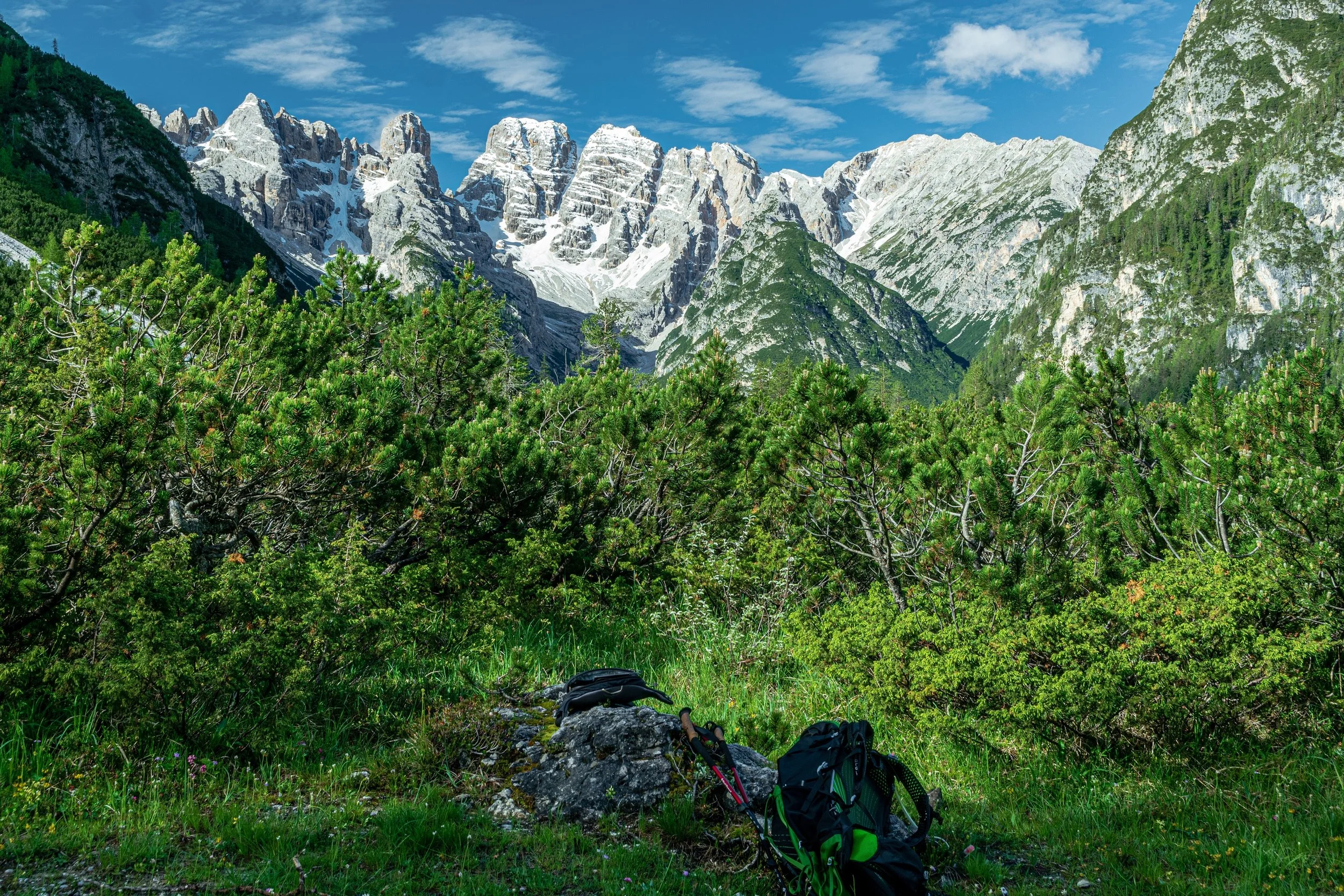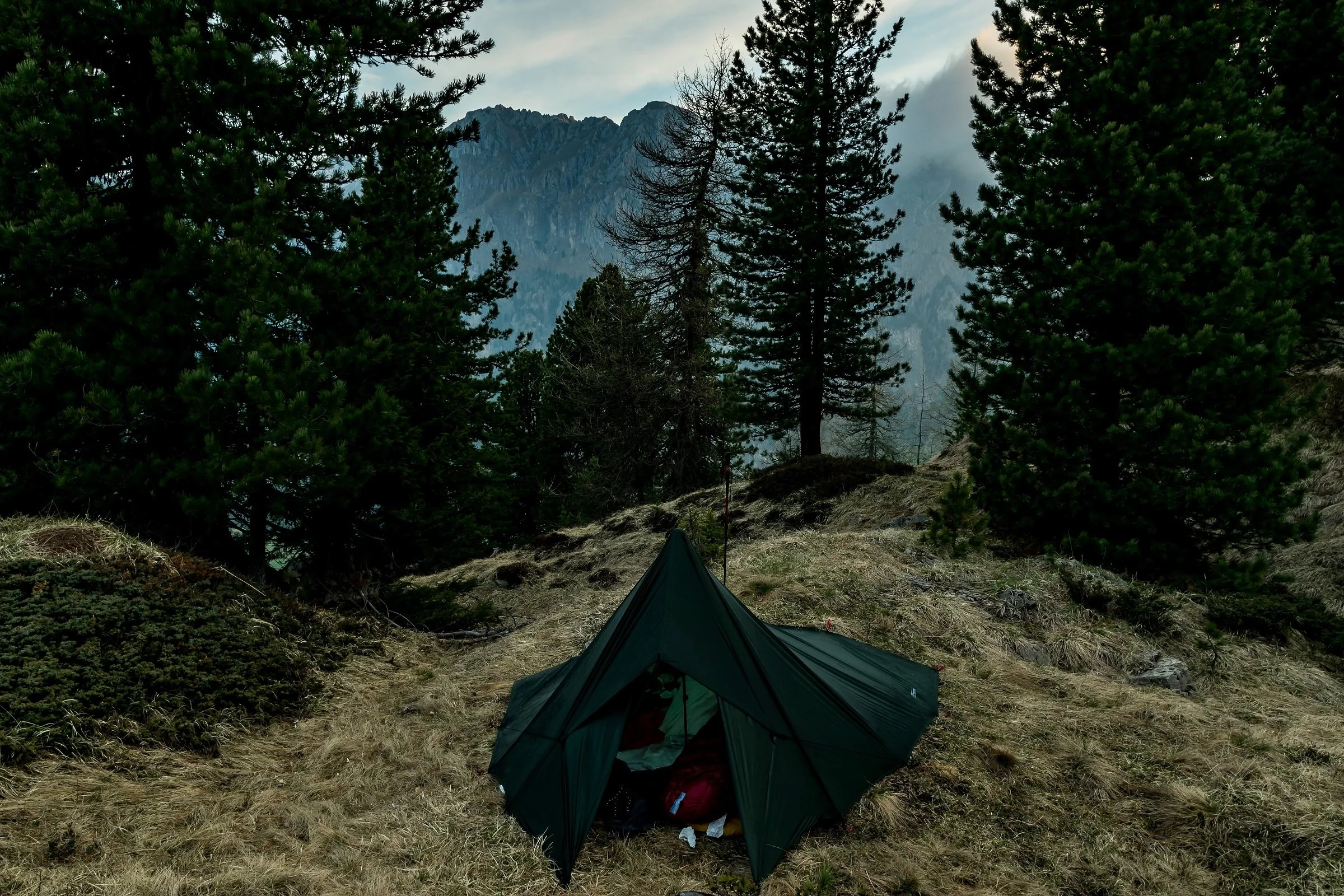Trekking and Wild Camping in the Alps
DD Hammocks Superlight Tarp converted to shelter using trekking poles
Trekking | Wild Camping in the Alps
In America, we hike from designated campground to designated campground, especially inside National Parks, and mostly with a required fee permit from the National Park Service. There are no fees to enter the National Parks of the Alps and use the expansive trail systems. In the Alps, multi-day ultralight backpacking could mean carrying 5 to 8 pounds including some snacks and water with a 24 liter backpack if one is bouncing from hut to hut. Hut hopping is the expected norm for hikers in the Alps as there are many well spaced private and alpine club huts throughout the Alps. The main difference between America and most of Europe is wild camping with a tent is strictly forbidden and may result in very heavy on the spot fines. There are no designated National Park camping areas in the Alps.
Camping (illegal) verses bivouacking (legal) is a very grey area in the Alps. Illegal wild camping means using a tent or structure to spend extended time beyond a brief pause at a single location on public lands. Legal bivouac is basically cowboy camping on the ground with a blanket or in a bag. Naturally, camping on private land without owner permission is trespassing as it is in America. Most of the land in the Alps and Bavaria are public lands. I’ve discovered the expected norm of hopping from one over-crowded hut to another over-crowded hut isn’t to my liking. Without getting into details, sleeping in a large open bay dorm with three level bunk-beds with a bunch of snoring strangers with varying bladder release times is the least appealing adventure one can dream of.
Gschnagenhardt Alm Hut
I don’t wish to paint a totally bad picture of our mountain huts as they provide a valuable service to mountain hikers. I’m a member of the German Alpine Club, Deutscher Alpenverein, (DAV) with affiliations with Austrian and Italian Alpine clubs. This affiliation allows ridiculously cheap overnight lodging throughout the Alps including winter when most huts are closed for the season. I enjoy staying in huts on weekdays when the crowds are small and privacy is such that a good night’s sleep can be had. There is an exception–never in August as every Italian and half of Europe are on a 30 day vacation at the same time. The food is usually excellent; meaning I do not need to pack a heavy load of food as a hut is never too far away for a good meal, and a warm shower from time to time. Usually, a night of socializing over drinks with like-minded wanderers can produce lifelong friendships. In winter when club huts are closed, most offer a self service winter room for its members featuring a dorm with several beds, blankets, and usually enough wood to start a fire in a stove to stay warm. I’ve found most of the time these winter rooms unoccupied and I spend the night alone. The unwritten rule is always leave a winter room better than when you arrived and leave a few provisions for the next wanderer. These rooms often become emergency shelters in heavy weather more than planned stopovers.
There is another undesirable option and that is to camp in private campgrounds spread throughout the Alps in surrounding communities on the edges of National Parks. These private campgrounds cater to multi-overnight stays mainly to individuals with motor homes and camp trailers. These campers are generally day hikers. One night thru-hiking tent campers go to the end of the line for space available. And, when one foreign accent speaking American asks for two trees to hang his tarp and hammock there’s usually unruly laughter. Again, here I’m faced with overcrowded cramped postage stamp camping spots full of people who desire public facilities, running water, showers and readily available food and drink. Campgrounds are often overrun by people with yellow license plates. :) These campgrounds are also quite expensive and may cost per person as much as spending the night in a private room in a nearby Gasthof with breakfast. This isn’t my idea of enjoying wide-open mountain spaces with views of the stars.
Monte Specie with DD Hammocks SuperLightTarp and light weight Outdoor Reserach Bug Bivy
These rules of camping put me in a bit of a dilemma, especially during summer hiking season. As I mentioned earlier, cowboy camping for a single rest pause (overnight bivouac without a structure/tent) is not illegal but still frowned on by many park rangers in the summer months when the huts are open and by Jagers in late fall during hunting season. When the huts close for the season most rangers close their eyes even to tents in the wild unless one builds a fire. Another strict illegal act is building a fire of any kind, especially if the fire is within 100 meters of a forested area. This violation can even be construed by some overzealous rangers as using a simple gas flame of your portable stove to heat up a cup of coffee. So to enjoy my thrill of wide-open spaces without the crowds, I push these very grey camping laws to their limits. I’ve resorted to stealth camping with a hammock and tarp system. It’s possible to use my hammock system in trees in a stealth mode (technically illegal) or as a ground bivy (legal) above the tree line during long treks across the Alps when a hut is either unavailable or undesirable.
Stealth camping means being as discreet as possible away from public ways and trails in hidden spots hanging in the trees. It means no campfires, and using my Jetboil Minimo in a limited capacity for necessities such as hot early morning coffee. I do know this one very likable ranger in the Prags Naturpark in the Dolomites that can smell brewing coffee a mile away. He once track the smell of my brew right down to my cup; then shared my coffee with a warning, a wink and a smile. When I say make early coffee, I mean before the first bird sings. Stealth means hanging my DD Hammock at dusk with the last light of day and sometimes in complete darkness. It means everything inside the backpack before the sun comes over the mountain and the first person on the trail in the morning. Bivouacking is less evasive and is my preferred method of camping.
Pause below Cristallo Group
I enjoy not worrying so much about breaking international laws. Cowboy camping or bivouacking on or near a peak can be one of the most exhilarating experiences one can have. Being discreet is still a necessity; fires are still forbidden, and some rangers and most Jagers will push this grey area of the law in their favor when possible especially if one has trashed the area or trampled the edelweiss. One will eventually come face to face with a gun toting early morning Jager checking up on his wild herd of Chamois or Red Deer. Jagers have no legal authority to request your identity documents and can only grumble or make false threats. It’s best if one encounters a rude Jager to pack up and move on especially in hunting season. When bivouacking, I convert my DD hammock into a bug proof ground bivy with the DD Hammocks Superlight Tarp overhead. When I know most of my hike will be above the tree line I leave the hammock at home. Instead, I use an Outdoor Research Bug Bivy which weighs half the weight of the hammock combined with my DD Hammocks Superlight Tarp. When rain or a heavy dew is forecast (photos above) I convert my tarp into a simple tent, but when I do I’m technically breaking the law with a covered structure. No one has ever complained or warned me with a simple mountain bivouac.
Monte Medalges DD Hammocks Superlight Tarp (460 grams) converted to weatherproof shelter
I don’t wish to give the wrong impression of Park Rangers and Jagers. These folks are also lovers of our natural environment and appreciate those who share their passions. Stealth campers will rarely be chastised by authorities, and at most given a simple verbal warning. I also have a logical excuse that I’m legally photographing the Milky Way all night, and thus rangers are more interested in my photos than worrying about my indiscretions. I always keep a few nice Milky Way photos stored on my camera’s memory card. :) It’s individuals taking to the wild to have a party with drinking, loud music, multiple tents, and campfires that spoil it for many dedicated nature loving campers. This party behavior is the main focus of Rangers, Forest Managers, and Jagers. When caught these people are not just fined. They are taken straight to jail with heavy fines exceeding 1000 Euros.
Hiking through the Alps is an unforgettable experience. Long distance trekking the Alps with a camera is my life’s dream come true. I hope to share many experiences in the years to come with all who wish to join me here.



